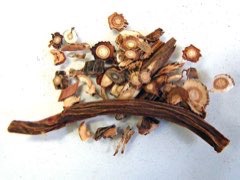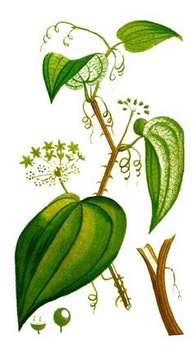 |
|
http://www.edibleplants.org |
 |
| botanicalimage.com |
Translate this page:
Summary
Smillax officinalis, otherwise known as Honduran sarsaparilla, is a tropical plant that can be found in Central America and Honduras. It grows up to 50m long. It is widely used medicinally against sexual impotence, rheumatism, joint pains, headaches, common cold, skin ailments, gout, etc. The roots are dried and used as flavoring in beverages, ice cream, candy, and baked goods.
Physical Characteristics

 Smilax officinalis is an evergreen Perennial Climber growing to 25 m (82ft) by 0.5 m (1ft 8in) at a fast rate.
Smilax officinalis is an evergreen Perennial Climber growing to 25 m (82ft) by 0.5 m (1ft 8in) at a fast rate.
See above for USDA hardiness. It is hardy to UK zone 10.
Suitable for: light (sandy), medium (loamy) and heavy (clay) soils and prefers well-drained soil. Suitable pH: mildly acid, neutral and basic (mildly alkaline) soils. It can grow in semi-shade (light woodland) or no shade. It prefers moist soil.
UK Hardiness Map
US Hardiness Map
Synonyms
Smilax barbillana Cufod. Smilax bernhardii Apt Smilax chiriquensis C.V.Morton Smilax gilgiana Apt Sm
Plant Habitats
Edible Uses
Edible Parts: Root
Edible Uses: Condiment
The root has been used as an ingredient in root beer and other beverages, where it is valued for its foaming properties, not for its flavouring properties[318 ].
References More on Edible Uses
Medicinal Uses
Plants For A Future can not take any responsibility for any adverse effects from the use of plants. Always seek advice from a professional before using a plant medicinally.
Anodyne Antiarthritic Antibacterial Antibiotic Antifungal Antiinflammatory Antirheumatic Antitussive
Blood purifier Cancer Depurative Diaphoretic Digestive Diuretic Eczema
Febrifuge Hepatic Hypotensive Kidney Leprosy Skin Tonic
Urinary
Sarsaparilla root has long been used as a traditional medicine in Central and South America, where it is employed in the treatment of sexual impotence; rheumatism and joint pain; headaches; the common cold; skin ailments, including leprosy; and as a general tonic in cases of physical weakness[318 ]. The plant has become popular as a herbal remedy in many parts of the world and considerable research has been carried out into the medically active compounds in the root. The most important active compounds in the root are a range of plant steroids and saponins; other compounds present include flavonoids[318 ]. The saponins have been shown to facilitate the body's absorption of other drugs and phytochemicals, which accounts for its history of use in herbal formulas as an agent for bioavailability and to enhancement the power and effect of other herbs[318 ]. Clinical research has validated the traditional use of sarsaparilla for skin conditions such as psoriasis, eczema, acne, and leprosy. In one clinical study with 92 patients it was reported that use of the root improved psoriasis lesions in 62% of cases and completely cleared lesions in 18% of cases. The root's blood cleansing properties are believed to be largely responsible for this, and in particular the steroid sarsaponin, which has been shown to remove endotoxins from the blood[318 ]. Sarsaparilla's effective use in the treatment of leprosy has been documented in a 1959 human trial[318 ]. The effectiveness of sarsaparilla in the treatment of adolescent acne caused by excessive androgens has received some experimental support as well[318 ]. Flavonoids in sarsaparilla have been documented to have immune modulation and liver protective activities[318 ]. Clinical observations in China demonstrated that sarsaparilla was effective (according to blood tests) in about 90% of acute and 50% of chronic cases of syphilis[318 ]. Other studies have show the antibiotic, antifungal and antimycobacterial properties of the root[318 ]. Its anti-inflammatory activity has been demonstrated in several in vitro and in vivo studies[318 ]. The root has been reported to have stimulatory activity on the kidneys in humans and, in chronic nephritis, it was shown to increase the urinary excretion of uric acid[318 ]. Saponins and plant steroids found in many species of plants (including sarsaparilla) can be synthesized into human steroids such as oestrogen and testosterone. This synthesis has never been documented to occur in the human body - only in the laboratory[318 ]. The steroids sarsasapogenin and smilagenin have been claimed to have the ability to treat senile dementia, cognitive dysfunction, and Alzheimer's disease. Any studies to substantiate these claims, however, have not yet been published in peer-reviewed papers[318 ] In modern herbalism, the root is considered anodyne, antibacterial, antibiotic, antifungal, antiinflammatory, blood cleanser, depurative, diaphoretic, diuretic, digestive, febrifuge, hepatic and tonic[318 ]. Through its reputation as a blood cleanser, the root has had a long history of use for syphilis and other sexually-transmitted diseases throughout the world. It is also used in the treatment of conditions such as gout, syphilis, gonorrhoea, rheumatism, wounds, arthritis, fever, cough, scrofula, hypertension, digestive disorders, psoriasis, skin diseases, and cancer[318 ]. The root is also widely available in health food stores, with a variety of tablets, capsules, and tincture products sold today. It can be found, both on its own or as an ingredient in various herbal remedies, where it is recommended for skin disorders, libido enhancement, hormone balancing, and sports nutrition formulas. It's also commonly used in herbal preparations as a synergist or bioavailability aid - as it is thought that the saponins in sarsaparilla root increase the absorption of other chemicals in the gut[318 ].
References More on Medicinal Uses
The Bookshop: Edible Plant Books
Our Latest books on Perennial Plants For Food Forests and Permaculture Gardens in paperback or digital formats.

Edible Tropical Plants
Food Forest Plants for Hotter Conditions: 250+ Plants For Tropical Food Forests & Permaculture Gardens.
More

Edible Temperate Plants
Plants for Your Food Forest: 500 Plants for Temperate Food Forests & Permaculture Gardens.
More

More Books
PFAF have eight books available in paperback and digital formats. Browse the shop for more information.
Shop Now
Other Uses
Hedge
Agroforestry Uses: The stems of many Smilax species are covered with prickles and, sometimes, these vines are cultivated to form impenetrable thickets (which are called catbriers or greenbriers)[318 ]. Other Uses None known
Special Uses
Hedge
References More on Other Uses
Cultivation details
The root, when used for medicinal purposes, is long and tuberous-spreading 180 - 250cm long. It is odourless and fairly tasteless[318 ].
References Carbon Farming Information and Carbon Sequestration Information
Temperature Converter
Type a value in the Celsius field to convert the value to Fahrenheit:
Fahrenheit:
The PFAF Bookshop
Plants For A Future have a number of books available in paperback and digital form. Book titles include Edible Plants, Edible Perennials, Edible Trees,Edible Shrubs, Woodland Gardening, and Temperate Food Forest Plants. Our new book is Food Forest Plants For Hotter Conditions (Tropical and Sub-Tropical).
Shop Now
Plant Propagation
Seed -
Other Names
If available other names are mentioned here
salsaparrilha, salsaparrilha de minas de gerais, salsaparrilha do mexico, salsaparrilha do para.
Native Range
SOUTHERN AMERICA: Colombia
Weed Potential
Right plant wrong place. We are currently updating this section.
Please note that a plant may be invasive in one area but may not in your area so it's worth checking.
Conservation Status
IUCN Red List of Threatened Plants Status : This taxon has not yet been assessed

Growth: S = slow M = medium F = fast. Soil: L = light (sandy) M = medium H = heavy (clay). pH: A = acid N = neutral B = basic (alkaline). Shade: F = full shade S = semi-shade N = no shade. Moisture: D = dry M = Moist We = wet Wa = water.
Now available:
Food Forest Plants for Mediterranean Conditions
350+ Perennial Plants For Mediterranean and Drier Food Forests and Permaculture Gardens.
[Paperback and eBook]
This is the third in Plants For A Future's series of plant guides for food forests tailored to
specific climate zones. Following volumes on temperate and tropical ecosystems, this book focuses
on species suited to Mediterranean conditions—regions with hot, dry summers and cool, wet winters,
often facing the added challenge of climate change.
Read More
Expert comment
Author
Kunth
Botanical References
Links / References
For a list of references used on this page please go here
A special thanks to Ken Fern for some of the information used on this page.
Readers comment
| Add a comment |
|
If you have important information about this plant that may help other users please add a comment or link below. Only comments or links that are felt to be directly relevant to a plant will be included. If you think a comment/link or information contained on this page is inaccurate or misleading we would welcome your feedback at [email protected]. If you have questions about a plant please use the Forum on this website as we do not have the resources to answer questions ourselves.
* Please note: the comments by website users are not necessarily those held by PFAF and may give misleading or inaccurate information.
To leave a comment please Register or login here All comments need to be approved so will not appear immediately.
|
Subject : Smilax officinalis
|
|
|
|